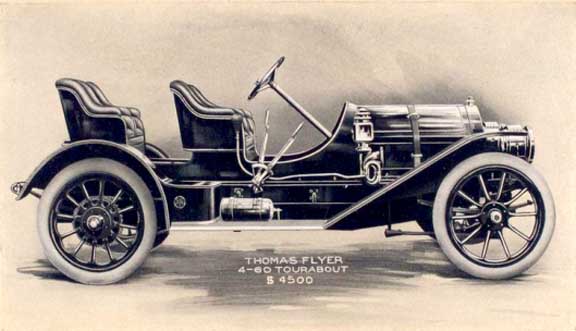1200 Niagara Street
Built 1901-1902; Rear buildings: 1905-1909
Architect: Sidney H. Woodruff |
The
building
at 1200 Niagara Street is set on an extensive polygonal lot,
located on the west side of the street that spans the block between
West Ferry Avenue and Breckenridge Street.
Niagara Street is a longstanding thoroughfare in the far
west of the neighborhood along the river. Already laid out in 1809,
Broadway as it was originally called, connected Buffalo
with Niagara Falls. Though currently dominated by aging
industrial and commercial properties, Niagara was once a residential
street with a number of fine dwellings - Buffalo’s first Delaware
Avenue. The transformation of Niagara Street from residential to
industrial began in the 1880s and 1890s.
The property is located in the far south western section of the Grant-Ferry-Forest
neighborhood.
An early twentieth century, urban, brick, office and factory
building complex. Multiple components- main, two-story, regular
rectangular building; additional factory buildings at the rear.
Facade defined by regular spaced, tiered single windowing with sills
and subtle arched openings. The main entrance with recessed arched
surround, sidelights, and flat roofed awning is located slightly off
center to the north on the lower facade.
Additional entrances at the far end of either side bay, set in
alignment with the windowing. Similar arched windowing pattern on
the side elevations. Small parapet at the front roofline.
The building at 1200 Niagara Street is significant as a good
representative example of an architect designed, early
twentieth century, urban, office and factory building complex. Built
as the office and factory building of the E. R. Thomas Motor Co.,
a nationally prominent early manufacturer of automobiles.
The three-story reinforced concrete factory buildings at the
rear were added in 1905-1909. Here were produced the famous
“Thomas Flyer” automobiles, one of which won the first New York to
Paris auto race in 1908.
Thomas sold the company in 1912, and the buildings were subsequently
used for other industrial purposes. Now used by Rich Products Co.
- Grant-Ferry-Forest,
Buffalo, NY Intensive Level Historic Resources Survey
|

E. R. Thomas

Source: 1905
Buffalo of Today: Domestic and Industrial
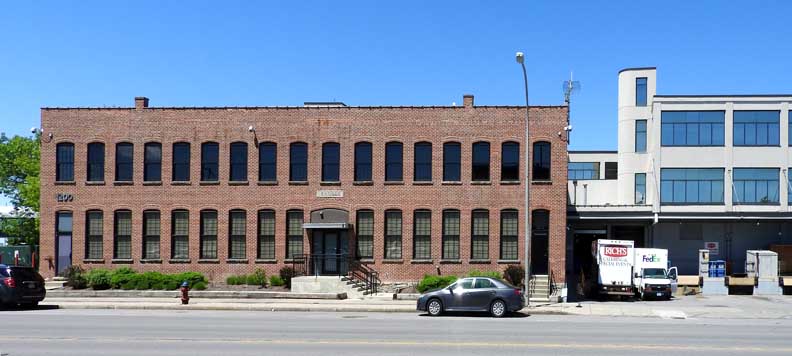
1902 building with 1909 addition ... Note
company name above the entrance (detailed below:)
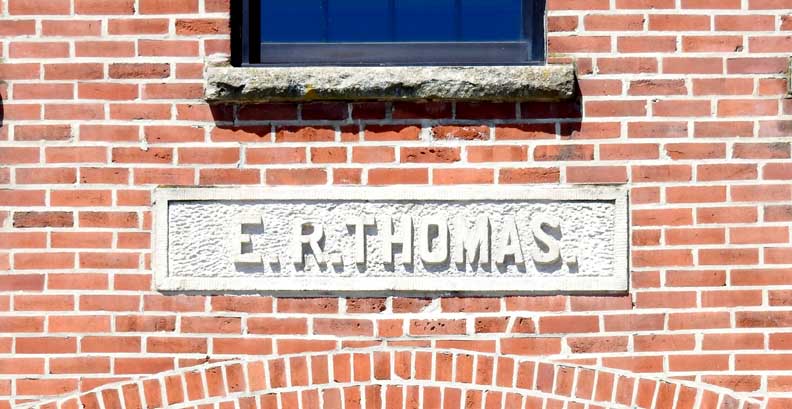
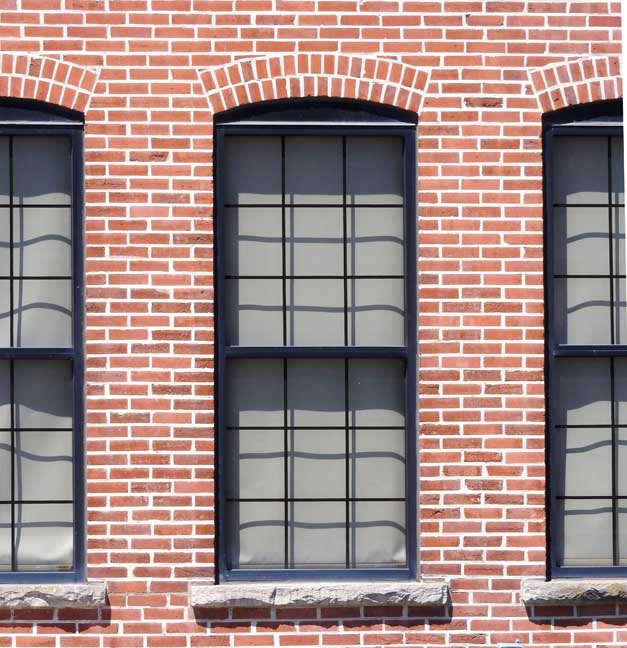

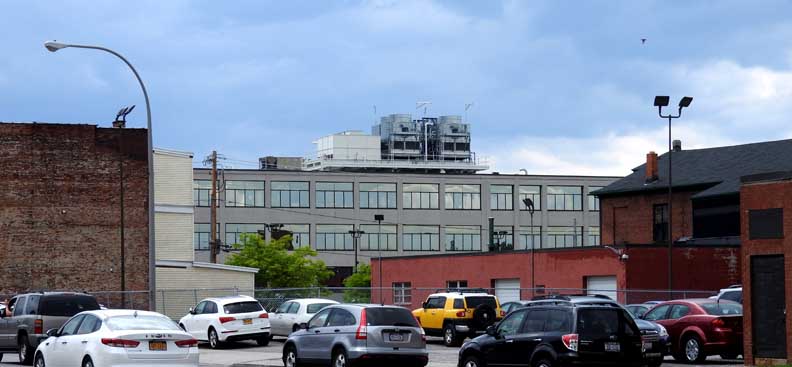

|
|
The Thomas Flyer made its claim to
fame when its 1907 model 35 was entered at the last moment in the
1908 New York to Paris Race. The 4-cylinder, 70-horsepower vehicle
was one of 5 vehicles to make the trip and the only American entry.
Thomas employee and Springville native George Schuster was the only
member of the Thomas crew to complete the entire 170-day, 12, 427
land mile trip.
The Thomas Flyer won the race and Thomas sales increased as a result
of the advertising, from 816 automobiles in 1908 to 1,035 in 1909.
But the Thomas Motor Company began its rapid decline when Henry Ford
introduced the cheap, quickly built Model T. Despite E. R. Thomas'
insistence that the "low-class" automobile would fade away because
people would prefer the "high-class" vehicles like the Thomas, the
buying public proved otherwise. In 1910, 913 Thomas Flyers were
sold, and 356,000 Ford Model T's.
E.R. Thomas sold the failing company in 1911 to a financial firm
that tried to save it. But by 1913, a bankruptcy sale was held and
nearly all that remained of the company was its factory complex,
adaptively re-used in 2006 by the Rich Products Corporation.
- Western
New York Heritage magazine (online June 2017)
|
|
The Thomas Flyer
E. R. Thomas made the Cleveland
bicycles in Buffalo in the late 1800s. In 1900 Thomas
began production of motorized motorcycles and then engines
from 1901 to 1902.
His first automobile was built in 1899 and called
the Autotwo. From 1900 to 1902 Thomas granted a
license to The Buffalo Automobile & Auto-Bi Co. who
built the American Automobile called the Buffalo. In
1902 The E. R. Thomas Motor Car Co. was formed and
Thomas took over Buffalo operations.
In 1903 Thomas introduced a double chain driven Touring
Car powered by a three cylinder in line engine that
developed 24 horsepower. Shown above in this vintage
advertisement it was called "An Automobile For Family Use".
This car was priced at $1250.00 to $1400.00.
The name Thomas Flyer was applied to the American
Automobiles produced in 1905 to about 1912. The most famous
model was a 1908 72 horsepower six cylinder Thomas Flyer
that won the New York to Paris automobile race in
1908. In the race the Thomas Flyer drove around the world in
169 days. Winning the 1908 New York to Paris race had a
short but positive effect on Thomas Flyer sales.
In 1911 the E. R. Thomas Motor Co. was reorganized into The
E. R. Thomas Motor Car Co. due to poor sales. By the end of
1912 The E. R. Thomas Motor Car Co. was in receivership.
Which resulted from actions in the equity brought by the
creditors because The E. R. Thomas Motor Car Co. was
unable to meet its obligations. The last cars from Thomas were
built to order in 1918, and possibly as late as 1919.
- American
Automobiles (online June 2017)
|
|
The E. R. Thomas Motor Car Co.
In 1895 Edwin R. Thomas formed a
partnership with H. A. Lozier in Toronto to manufacture bicycles. In
1900 he sold out to the Canada Cycle and Motor Co. of which he was
vice president; then shortly afterwards he resigned this position
and moved to Buffalo where he set up business in the old Globe
Bicycle factory at Elm St. and Broadway. Here he soon turned
to the manufacturing of motorcycles.
The first automobile which the Thomas Company turned out was
assembled from parts made by the Covert Co. of Lockport. In 1903
it made its own model, a two passenger car with a one cylinder
motor, cooled by a radiator of horizontal tubes that hung over the
chassis. Later, it made three and four cylinder cars which sold from
$3,000 to $3,500. In 1908 it achieved international prominence by
entering a car in the first race around the world, an event
which was followed eagerly by the public throughout Europe and
America.
The Thomas arrived in Paris on July 30, four days behind the German
Protos. The Thomas won the race by 26 days, however, because of a
credit given for being the only car to go to Alaska, and the penalty
imposed upon the Protos for not driving all the way to San Francisco
on its own power. The distance the Thomas covered was 13,341 miles,
or 3,246 more than the Protos. The Italian lust reached Paris 49
days behind the Thomas.
When the Thomas car returned to Buffalo, world famous, it was
escorted from the city line to Lafayette Square by the 74th Regiment
Band and a parade of cars a mile long.
With this demonstration that the American car was the equal of the
European, the sales of the Thomas Co. boomed temporarily. Its
factory at c was busy night and day turning out taxis
and fire engines as well as pleasure cars.
The company was soon in difficulty, however. Even its world- wide
publicity could not sustain an inferior product. The next two
models, the L and M, were so poorly designed, according to Schuster,
that they gave endless trouble to their owners and the dealers, and
brought about a loss of personnel among both dealers and factory
men. The Model L was noisy, underpowered and leaked oil. The
company, furthermore, made the mistake of publishing false
information about the race in its official brochure. This
claimed that during the race the car was "never in the repair shop,
none of the valves ground or changed; not a spark plug was changed;
nor were the crankshaft bearing changed or adjusted."
While the rest of the industry was expanding rapidly, the company's
sales rose from 816 in 1908 to 1,036 in 1909 and then dropped to 913
in 1910. The model MX was a good one, but it was put out too late to
repair the damage.
In 1911 Mr. Thomas sold the company, of which he was the
sole owner, to the banking house of Eugene Meyer. The Meyer firm
brought in Packard men to straighten out the situation, but they
were unable to restore public confidence. The company went bankrupt
in August, 1912.
- Roger Squier, Adventures
in Western New York History: Manufacturers of Wheels and Motors
(online September 2017)
|
Edwin
R. Thomas
(1850-1936)
Invented the Thomas
Flyer, a sturdy automobile that he entered in an
around-the-world race from New York City to Paris in 1908. Every
automobile maker in the world wanted to participate in this
next-to-impossible race, so there was a vast number of entries.
The Thomas Flyer raced across the U.S., Canada, Alaska, Siberia,
Asia, and Europe, and after 16 months of travel over 16,000
miles, it arrived first at the finish line in Paris.
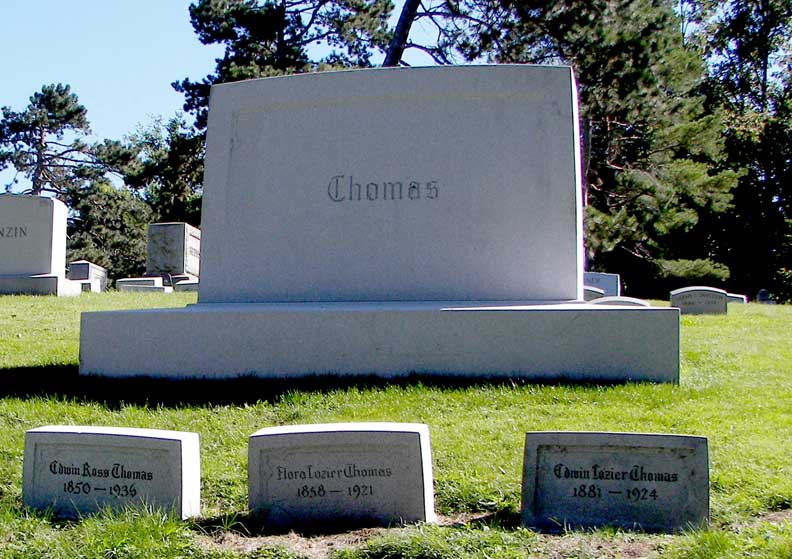 Forest
Lawn Cemetery, Section 26
Forest
Lawn Cemetery, Section 26
|












